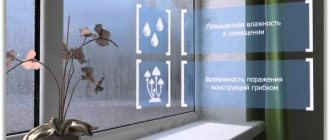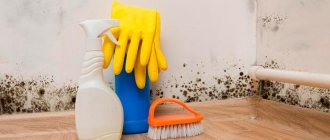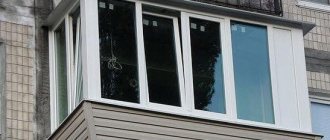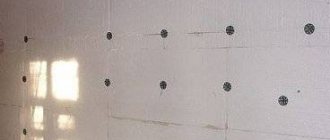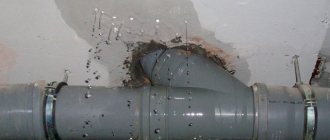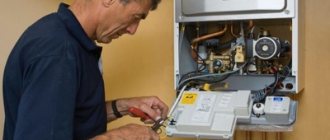Dampness on the walls is a common problem that can appear not only in an apartment, but also in a private house. It must be addressed immediately, because when the walls and corners become damp, not only the wallpaper begins to darken and peel off, but also mold appears.
Dampness on the walls can contribute to the emergence of various diseases, and become a gathering place for insects, mites and other fungi . If the wall in your apartment becomes damp, what should you do and where should you go?
Why does this happen?
The reasons for increased humidity on the walls can be different. They are mainly divided into internal and external. Most often, the apartment gets wet due to the following circumstances:
External moisture
This problem is typical for apartments located on upper floors with a poor drainage system.
Water can enter the walls through microcracks or poorly sealed seams. The wall can also become damp due to a drainpipe passing nearby.
To get rid of this problem, you will have to clean the walls from the damp coating, plaster them, prime them, and cover them with waterproofing mastic.
Such actions can be done independently either in a private house or in an apartment on the ground floor. In other cases, you will have to seek help from specialists.
Wall freezing
This phenomenon occurs when the temperature outside is too low and the air inside the room is not warm enough. Because of this, the walls begin to freeze, and moisture appears on its inner surface.
The wall can also freeze due to the presence of microcracks or leaky joints. To eliminate this problem, sometimes it is enough to increase the temperature in the room, but the most effective way is to additionally insulate the walls. In this case, it is better to give preference to exterior decoration.
Excessive humidity
If we are talking about a brick building, then a large amount of moisture is formed due to the basement. In other cases, replacing windows in the apartment can contribute to the appearance of pockets of dampness. This is explained by the fact that the installed plastic windows are very sealed and close the openings too tightly, so the ventilation of the room deteriorates.
As a result, condensation appears and the windows sweat. Sometimes it is enough to ventilate the room to avoid this problem. If it is not resolved, then you can try to improve the operation of the ventilation system.
Mold
To get rid of this problem, you need to treat the affected areas with an antifungal agent and re-cover with plaster.
Poor air ventilation
To avoid high humidity in the apartment, it is important that the ventilation system works properly . You can check the quality of its work using a piece of paper by placing it on the grate. If it holds and does not fall off, then there is traction and the channels are not clogged.
If there is no draft, you will need to install additional devices designed to establish air circulation. When there is no debris in the hole, but the draft is weak, additional slits are made at the bottom of the door so that air flows better. If these measures do not help, then specialists install a forced exhaust in the ventilation duct.
Additional reasons
Additional reasons include insufficient heating of the room, too thin walls, formation of voids in floor slabs, etc.
Often, dampness in a home is caused by improper foundation insulation . If its waterproofing is insufficient, then if groundwater rises by more than 1.5 meters, it can penetrate the walls. In this case, the manifestation of excess moisture will be observed under the baseboards, the plaster will begin to fall off, and the wallpaper will peel off.
Sometimes you can see how only the upper corners become damp. This problem occurs more often in the cold season. In private houses or apartments on the top floors, dampness occurs due to the attic. This happens when:
- Wetting can occur due to improper attic insulation. Most often, damp spots appear in those places where the attic floor is adjacent to the external walls.
- Poor attic ventilation. If the ventilation system works well, then the temperature remains at the same level over the entire roof surface in cold weather.
Wall freezing
The most common and unpleasant reason for the appearance of moisture on the walls in a room is their freezing. Experts involved in thermal insulation of premises use the term “dew point”. Without going into too much technical detail, this is the temperature at which steam turns into liquid. That is, in our case, condensation will appear on the inner surface.
If the air temperature outside is low and the air in the room is not warm enough, then there is a chance that the wall will freeze. After which moisture will appear on its inner surface. The probability of dampness of the walls indoors is even higher if there are “cold bridges”. Their role can be played, for example, by microcracks in walls or leaky joints in panel houses.
dampness in the apartment's internal walls
How to deal with damp walls in this case?
Sometimes increasing the room temperature helps. In this case, the “dew point” goes inside the wall. But without unnecessary labor costs, this can only be done in private houses with an autonomous heating system. At the same time, the consumption of gas and money to pay for it will increase. In apartments with central heating, the temperature can only be increased by increasing the number of battery sections.
The most effective way to combat freezing of external walls is their additional insulation. This can be done both from the inside and outside.
Insulating the wall from the inside is considered less labor-intensive. For this, one of the many insulation materials that are commercially available can be used. Most often, polystyrene foam and mineral wool are used for these purposes. Less often - polystyrene foam. Work on internal insulation can be done independently. But this option has a number of significant disadvantages. Firstly, the insulation sheets will “eat up” precious centimeters of room space. And for rooms with dimensions of one and a half dozen squares, this will be noticeable. Secondly, despite all the manufacturers’ statements about the absolute harmlessness of their materials, there is a possibility that harmful fumes will appear in the room. Thirdly, if the thickness of the insulation is incorrectly calculated, it may turn out that the “dew point” will be at the junction between the insulation and the wall. And then you will get a hidden source of moisture and mold formation. The situation is even worse than damp walls in the apartment.
When adding additional insulation to walls, it is better to give preference to exterior work. But, again, such work can be done independently only on the ground floor and in a private house. In all other cases, the involvement of professionals is inevitable.
When insulating walls externally, the heat-insulating material is attached to the wall using special adhesive mixtures and plastic dowels. Then a mesh is laid on top under the plaster and the surface is plastered. After cleaning and sanding, you can begin painting. To prevent moisture from rain and melting snow from getting between the insulation and the wall, a protective canopy made of galvanized metal sheets is mounted along the upper end of the insulation.
Related article: How to remove old putty from walls
What to do
Having found out the reason why the walls get wet, the question arises of eliminating excess moisture.
If such a situation arose after renovation, then it is enough to ventilate the rooms more often. If this is a cold period of time, then it is important that the room is warm enough.
If the batteries are not enough, you can use additional heaters. When the problem lies in ventilation, you can try to remove foreign objects that interfere with normal air circulation.
Insufficient waterproofing is a more complex situation. Eliminating the problem consists only of finding the area where the water comes from and isolating it well. The main source is seams on the outside of the house. This task should only be solved by specialists.
Why do the walls in the house sweat and get wet and how to fix it
With the onset of cold weather, many residents of apartments and houses are faced with the problem of wet walls, especially in the corners. Some people do not attach any importance to this, but subsequently this moisture gradually develops into mold, and then health problems may arise for residents, such as frequent coughing and various illnesses, shortness of breath, allergies, etc.
The problem of wet walls in the house must be taken very seriously, and if you neglect it, the consequences can be disastrous.
If the fogging of the walls has already developed into the formation of mold, then ordinary scraping is not enough, since after a short period of time it will again grow on the wall, no matter what you treat it with. Here we need to look for other solutions, and specifically, get rid of moisture in the walls.
Related article: How to attach a Mauerlat to a brick wall
In order to find a solution to the problem, it is necessary to determine its source, and in a particular case, find the reason why the walls in the house are sweating and getting wet.
Another important aspect is that several simple measures can help to localize the resulting moisture stain on the wall and prevent it from growing. First, you need to remove all obstacles to air circulation in that place (curtains, rags, etc.), and then install a heater with a fan directed at the spot (even just a fan), this way you will improve the situation a little.
Where to contact
If all possible options for eliminating dampness do not help, then you need to write a statement and submit it to the management company. It is drawn up in writing and in two copies. The paper should contain detailed information about when the corners or walls began to get wet, and an exact indication of the location.
ATTENTION! After submitting your application, it is important to ensure that it is recorded. The applicant must keep one copy with a mark.
The next action of the management company should be to send a technician to inspect the residential premises, based on the results of which a report on the presence of dampness and the reasons for its occurrence will be drawn up. The apartment owner must request a copy of this document.
As soon as the act is drawn up, the management company must decide on the option for repair work, as well as the time frame by which it will be completed. It is advisable for the apartment owner to take a copy of each document. If the repairs are not carried out or the period is significantly delayed, then these copies can be contacted with the relevant authorities.
Preventing dampness
If certain recommendations are followed, the appearance of dampness can be prevented or minimized. Basic Rules:
- It is advisable to dry laundry outside the living room or with the hood running.
- During cooking, the dishes must be covered with a lid to prevent steam from escaping from them.
- In the bathroom, where the highest concentration of moisture is contained, as well as in the kitchen, you need to periodically clean the ventilation openings from clogging. Also, these rooms require systematic ventilation.
- In a private house, you can try to insulate the attic space. In addition, you can cover the walls with waterproofing material.
- It is recommended to use flammable substances less frequently, such as paraffin, which contributes to the appearance of moisture.
- Correct errors in the heating system in a timely manner.
- You can use a dehumidifier to reduce humidity. This device easily fixes the problem. It is also quite compact, which makes it easy to move it to different rooms.
Experts recommend installing fans with a built-in humidity controller in the bathroom. If the humidity rises, it reacts automatically, eliminating excess moisture in the air.
ATTENTION! It is important to monitor the condition of the apartment and prevent the walls from becoming damp.
The fight against excess dampness in an apartment or in an individual residential building cannot be postponed until later. It must be started immediately, as this is a rather labor-intensive process, sometimes requiring financial costs.
If you accurately determine the cause and choose the right method to eliminate it, then you can forget about dampness for a long time.
Reasons for education
Before you deal with moisture, you need to find its source. Often dampness on the walls is the result of a complex of reasons. The most common of them:
- Leaks - occur when the water supply system, sewer pipe, or roof roof is damaged;
- Poor ventilation;
- Unsuitable waterproofing of floors and foundations;
- A large number of house plants;
- External factors - proximity to a river, heavy rains, groundwater, etc.
However, the most important factor in high humidity is the person himself. Under normal conditions, an adult produces up to 2.5 liters of water vapor per day, including that during cooking, washing, water procedures, etc. Even a slight deviation from the norm, for example, when drying clothes in the bathroom, is fraught with consequences.
Related article: How to soundproof a wall from neighbors

